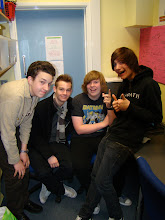1. The Action: identify the event your idea is based around; what actually happens (discovery of a body, an illicit meeting, a witness seeing a crime being committed, a criminal act taking place)?
A body is lying on a rooftop and has been shot in the chest and the audience doesn't know whether he is dead or alive. The killer/villain is seen leaving the scene of the crime and a voice over is hinting at the plot while this is all happening. The villian lights a cigarette and walks away. The person on the floor has disappeared and it is made clear that he is not dead.
2. The theme(s): what should it make the audience think about or feel, what 'issues' will it raise (revenge, sexuality, voyeurism, stalking, obsession, greed ect).
The opening is associated to: crime, enigma, suspense, death, motive, justice and retribution, secrecy and politics.
3. The narrative: how is it structured - classic narrative pattern or break with convention, different time zones, flashbacks/forwards, dreams etc. Will there be dialogue? What about diegetic/non-diegetic sound?
It is a linear real-time sequence, with use of diegesis on and off screen, such as police sirens in the distance. Also the use of a voice over to explain the film idea/story.
4. The character(s) who are they, identify their roles, what are their charactaristics, including gender, appearance etc?
Anti-hero, villain, detective/gangster, male, trench coats and matching hats, red roses, gun shot wound, hero on the floor who appears to be dying, blood, smoke from a cigarette, no remorse from the villain (has killed before)?
5. The setting and choice of location: where is it set?
It's set in a 1970s dark industrial area on a rooftop, it is night time and the surroundings are dark. The rooftop is surrounded by taller buildings and we are given many atomospheric shots from high above giving the audience an impression of desolation, these two characters are setterling business where they are free to break the law.
6. The mise-en-scene: identify colours, lighting, dress codes, the overall visual look.
The look is very Sin City - esque with low saturation but contrasting colours which stand out e.g light and darkness. The shots will have a low saturation mixed with various filters such as a low glow effect which brings out the white/light in the shots, also maybe some colour correction to make it look exactly as we want. There will be a strong emphasis on the colour red as it is of blood and we will want to make that visually striking the the audience. The characters will be dressed as gangsters with trench coats and the overall feel will be very 1970/80s to create a traditional film noir look.
7. The camera work: the style you are aiming for.
There will be some atomospheric master shots from tall buildings which will set the scene and create the look and feel for the time period. The camera work will be quite slow paced with lots of close-ups on the characters in order to show little background as this will clutter the shot. Since we have already established background through atomospheric master shots there's no need to when we want to focus on the characters and what their feeling.
8. The editing: edited as a continuous sequence, use of cross cutting, use of montage, or combination?
The opening will feature non-linear editing, edited as a continuous sequence which focuses on setting up the story and background infomation on the story eg. what is happening on the streets or in politics within the film, so in essence we are creating a whole new world where things are in chaos and are going wrong (no sign of democracy). The editing will be quite slow paced and we want a lot of the shots to linger on-screen to create a relaxed and artistic effect so the audience has time to take all of the mise-en-scene in which is important in an arty film.
9. Has your idea been 'tested' against the question on the previous brief sheet? Yes, it has and it appears to be very workable provided we work hard and focus on every detail to create this film noir genre. We have had issues with the story and are correcting them but there is nothing wrong with the general idea of the film.
10. Group responses?
We all agree that the idea is a very good one and that if done right it could potentially look very good. However, we also agree that the story needs more work in order for it to be understandable.
10. Teacher responses?
Daniel has posted the teacher responses to our initial proposal and we have taken all of it on board and are changing it eg. simplifying the story - No flashbacks, but instead a continuous sequence.
By Matt
Subscribe to:
Post Comments (Atom)

No comments:
Post a Comment